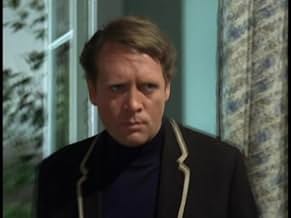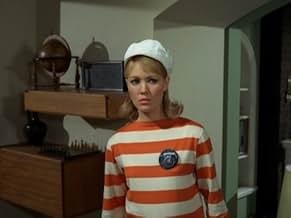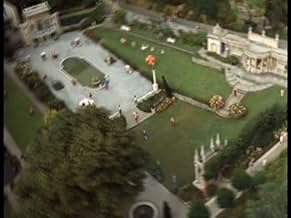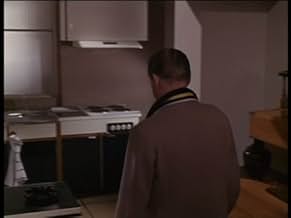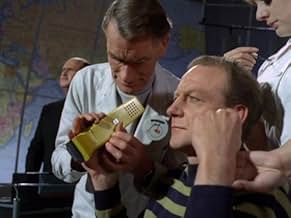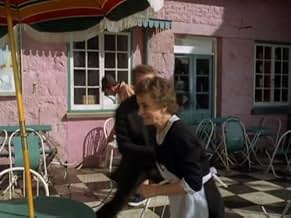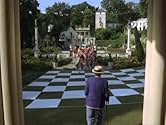इस्तीफा देने के बाद, एक पूर्व जासूस एक विचित्र गाँव में कैद कर लिया जाता है जहाँ वह भागने की कोशिश करता हुआ अपने अगवाकर्ताओं को जानकारी देने से इनकार करता है.इस्तीफा देने के बाद, एक पूर्व जासूस एक विचित्र गाँव में कैद कर लिया जाता है जहाँ वह भागने की कोशिश करता हुआ अपने अगवाकर्ताओं को जानकारी देने से इनकार करता है.इस्तीफा देने के बाद, एक पूर्व जासूस एक विचित्र गाँव में कैद कर लिया जाता है जहाँ वह भागने की कोशिश करता हुआ अपने अगवाकर्ताओं को जानकारी देने से इनकार करता है.
- पुरस्कार
- 1 जीत और कुल 1 नामांकन
एपिसोड ब्राउज़ करें
फ़ीचर्ड समीक्षाएं
This has become by far my favorite series of all time, so much so I have given up watching television altogether and turned to DVD's instead. That's not to say it's the best show ever, but it's one of those things you can watch as fluff action-adventure entertainment one day, or chew down to its bones, if you like, the next. That is, it doesn't require intelligence and concentration or an easy day at the office to enjoy, but if you've read a few books or have philosophical leanings you can amuse yourself by wringing quite a bit out of it.
On that note, it's especially fun to watch this series in conjunction with Danger Man/ Secret Agent. Although it isn't uncommon to have the same actors work together on different series, there is a town full of spies in DM/SA
referred to as the Village in the episode "Colony Three" which is the center of a debate on whether Number 6 and John Drake are the same. (McGoohan categorically denies this, but Markstein says it's true. Perhaps there is a legal hurdle involved? We will probably never get that information.)
I recommend watching them in order, so you can see Number 6 gradually abandon his open desperation and anger ("Arrival" to "The Chimes of Big Ben") for a cool and calculated needling of the system from within ("A, B and C" to "Hammer Into Anvil"). They try drugs, brainwashing, torture, virtual reality, letting him escape, and even babysitting to get him to talk. Each episode will appeal to someone different, some funny, some aggravating, but they all fit together by "Fall Out"; I have never met anyone who was not surprised at the final episode. It's truly extraordinary!
You will find references to the Prisoner are made constantly in other shows and movies, especially Sci Fi. The character Bester uses the Village greeting on Babylon 5; I have seen Village interrogation methods on the Pretender, John Doe and Farscape (whose leading man has an acting style similar to McGoohan's and a character similar to Number 6, IMHO, especially if you watch "A, B and C"); Number 2's trademark sphere chair is used on everything from Austin Powers to ads for American Idol.
The Village itself has appeared in tribute episodes of the Invisible Man and, of all things, the Simpsons ("The Computer Wore Menace Shoes"). Rover has actually appeared on the Simpsons twice!
I believe it's a classic that shouldn't be missed for anyone who ever feels trapped by rules that make little sense. If you like quoting Brazil and Office Space you'll find plenty of quotes to add to your collection here. My friends and I have even started referring to each other by number at work!
Be Seeing You!
On that note, it's especially fun to watch this series in conjunction with Danger Man/ Secret Agent. Although it isn't uncommon to have the same actors work together on different series, there is a town full of spies in DM/SA
referred to as the Village in the episode "Colony Three" which is the center of a debate on whether Number 6 and John Drake are the same. (McGoohan categorically denies this, but Markstein says it's true. Perhaps there is a legal hurdle involved? We will probably never get that information.)
I recommend watching them in order, so you can see Number 6 gradually abandon his open desperation and anger ("Arrival" to "The Chimes of Big Ben") for a cool and calculated needling of the system from within ("A, B and C" to "Hammer Into Anvil"). They try drugs, brainwashing, torture, virtual reality, letting him escape, and even babysitting to get him to talk. Each episode will appeal to someone different, some funny, some aggravating, but they all fit together by "Fall Out"; I have never met anyone who was not surprised at the final episode. It's truly extraordinary!
You will find references to the Prisoner are made constantly in other shows and movies, especially Sci Fi. The character Bester uses the Village greeting on Babylon 5; I have seen Village interrogation methods on the Pretender, John Doe and Farscape (whose leading man has an acting style similar to McGoohan's and a character similar to Number 6, IMHO, especially if you watch "A, B and C"); Number 2's trademark sphere chair is used on everything from Austin Powers to ads for American Idol.
The Village itself has appeared in tribute episodes of the Invisible Man and, of all things, the Simpsons ("The Computer Wore Menace Shoes"). Rover has actually appeared on the Simpsons twice!
I believe it's a classic that shouldn't be missed for anyone who ever feels trapped by rules that make little sense. If you like quoting Brazil and Office Space you'll find plenty of quotes to add to your collection here. My friends and I have even started referring to each other by number at work!
Be Seeing You!
Since its initial telecast, back in 1967, this enigmatic classic has evoked every reaction from awe to contempt. Given the amount of serious critical attention THE PRISONER has received, and given that a whole society has been created in its honor, I'd say the awe has won out, and I vehemently agree that THE PRISONER deserves to be honored as one of the truly artistic programs created for commercial television.
However, I can also understand the frustration many viewers have felt. Over the course of its seventeen episodes, this offbeat spy thriller becomes further and further offbeat until it ultimately transforms into surrealistic allegory. I confess I'm not sure whether this transformation was intended as a complete surprise, or whether you were supposed to know where the show was going, but in either case, I think you can better appreciate the series if you can see the earlier episodes as preparation for what's to come.
THE PRISONER's title character is a British secret agent (series creator Patrick McGoohan) who may or may not be SECRET AGENT's John Drake. The story begins with him suddenly and mysteriously resigning, then just as suddenly and mysteriously being rendered unconscious and transported to a place known only as The Village, the location of which is known only to those who run it. The Village is a prison camp, but with all of the amenities of a vacation resort,. Attractive dwellings, shops, restaurants, etc. exist side by side with high-tech methods of keeping order and extracting information from those who won't give it up willingly.
Those who try to escape get to meet Rover, a belligerent weather balloon capable of locomotion, and seemingly of independent thought. It appears (to me anyway) that the authorities can summon Rover, send it away, and give it instructions, but that it acts more or less on its own initiative. Rover deals with fugitives by plastering itself against their faces, rendering them either unconscious or dead, depending on how bad a mood it's in. Twice, we see it haul someone in from the ocean by sucking them up into a whirlpool it creates.
Citizens of The Village, including those in authority, are identified only by numbers. Our protagonist is known only as No. 6 throughout the entire series. The Village is run by No. 2, who in turn reports to an unseen and unidentified No. 1. No. 1 is apparently an unforgiving boss, because No. 2 is always being replaced.
Shortly after he arrives in in the Village, No. 6 is informed, by the reigning No. 2, that he should count on remaining there permanently. If he cooperates, life will be pleasant and he may even be given a position of authority. If he resists -- well, the only restriction they're under is not to damage him permanently. To satisfy his captors, No. 6 need only answer one question: `Why did you resign?' His question in turn is, `Who runs this place? Who is No. 1?'
Most of the episodes deal with No. 6's attempts to escape, and/or his captors' attempts to break him, although there are a few side trips. Several episodes suggest that No. 6's own people may be involved with running The Village. Some of the episodes are fairly straightforward, while others leave you with questions as to exactly what went on. It's important to note that several of the more obscure episodes -- for example, `Free for All' and `Dance of the Dead' -- are among the seven episodes that McGoohan considers essential to the series.
And then we come to the final episode, `Fall Out,' which promises to answer all the burning questions the viewers have been anguishing over for seventeen weeks -- and which so frustrated and angered those viewers back in 1967 that McGoohan had to go into hiding for awhile. Of course, I can't reveal any of the really important details, because, as No. 2 says in the recap that begins most of the episodes, `That would be telling,' and as all of us IMBD contributors know, `telling,' is frowned upon. However, to come back to the point with which I started, you should be prepared for a resolution of an entirely different nature than the one you'll probably be expecting -- a resolution that forces you to rethink your entire concept of the Village, and of the intention of the series. If you aren't ready, you'll be frustrated. If you are, you can accept THE PRISONER is the spirit in which it was offered.
However, I can also understand the frustration many viewers have felt. Over the course of its seventeen episodes, this offbeat spy thriller becomes further and further offbeat until it ultimately transforms into surrealistic allegory. I confess I'm not sure whether this transformation was intended as a complete surprise, or whether you were supposed to know where the show was going, but in either case, I think you can better appreciate the series if you can see the earlier episodes as preparation for what's to come.
THE PRISONER's title character is a British secret agent (series creator Patrick McGoohan) who may or may not be SECRET AGENT's John Drake. The story begins with him suddenly and mysteriously resigning, then just as suddenly and mysteriously being rendered unconscious and transported to a place known only as The Village, the location of which is known only to those who run it. The Village is a prison camp, but with all of the amenities of a vacation resort,. Attractive dwellings, shops, restaurants, etc. exist side by side with high-tech methods of keeping order and extracting information from those who won't give it up willingly.
Those who try to escape get to meet Rover, a belligerent weather balloon capable of locomotion, and seemingly of independent thought. It appears (to me anyway) that the authorities can summon Rover, send it away, and give it instructions, but that it acts more or less on its own initiative. Rover deals with fugitives by plastering itself against their faces, rendering them either unconscious or dead, depending on how bad a mood it's in. Twice, we see it haul someone in from the ocean by sucking them up into a whirlpool it creates.
Citizens of The Village, including those in authority, are identified only by numbers. Our protagonist is known only as No. 6 throughout the entire series. The Village is run by No. 2, who in turn reports to an unseen and unidentified No. 1. No. 1 is apparently an unforgiving boss, because No. 2 is always being replaced.
Shortly after he arrives in in the Village, No. 6 is informed, by the reigning No. 2, that he should count on remaining there permanently. If he cooperates, life will be pleasant and he may even be given a position of authority. If he resists -- well, the only restriction they're under is not to damage him permanently. To satisfy his captors, No. 6 need only answer one question: `Why did you resign?' His question in turn is, `Who runs this place? Who is No. 1?'
Most of the episodes deal with No. 6's attempts to escape, and/or his captors' attempts to break him, although there are a few side trips. Several episodes suggest that No. 6's own people may be involved with running The Village. Some of the episodes are fairly straightforward, while others leave you with questions as to exactly what went on. It's important to note that several of the more obscure episodes -- for example, `Free for All' and `Dance of the Dead' -- are among the seven episodes that McGoohan considers essential to the series.
And then we come to the final episode, `Fall Out,' which promises to answer all the burning questions the viewers have been anguishing over for seventeen weeks -- and which so frustrated and angered those viewers back in 1967 that McGoohan had to go into hiding for awhile. Of course, I can't reveal any of the really important details, because, as No. 2 says in the recap that begins most of the episodes, `That would be telling,' and as all of us IMBD contributors know, `telling,' is frowned upon. However, to come back to the point with which I started, you should be prepared for a resolution of an entirely different nature than the one you'll probably be expecting -- a resolution that forces you to rethink your entire concept of the Village, and of the intention of the series. If you aren't ready, you'll be frustrated. If you are, you can accept THE PRISONER is the spirit in which it was offered.
When I saw the first episode of this series, my jaw dropped in amazement. Here was a TV series that was entertaining and actually made you think. Nothing was ever what it appeared, no one had a real name, you never knew who was the good guy or the bad guy (or if they were one in the same!). The "final" episode was what could only be described as PSYCHEDELIC.
This TV series was, and still is, way ahead of its time.
As a side note, there is a "lost" first episode that is wildly different than the first one generally aired that explains some of the symbolism used in the series.
I hope the movie remake is made and distributed.
This TV series was, and still is, way ahead of its time.
As a side note, there is a "lost" first episode that is wildly different than the first one generally aired that explains some of the symbolism used in the series.
I hope the movie remake is made and distributed.
Who would think that the coolest show of 2004 would have been the rebroadcast of this 1960's British classic?
When I lived in the U.K. I heard about this show a lot, and when I went to Wales was told about the town where it was filmed, but I had no idea why people were so durned excited about it.
It can be murky and deliberately obscure, but I'm not sure I've ever seen a show as creative and bizarre....and you have to love the fact that No. 6 always looks so dammed serious!
Seriously, it's worth watching, if only to remember how important good writing and unique ideas used to be in television!
When I lived in the U.K. I heard about this show a lot, and when I went to Wales was told about the town where it was filmed, but I had no idea why people were so durned excited about it.
It can be murky and deliberately obscure, but I'm not sure I've ever seen a show as creative and bizarre....and you have to love the fact that No. 6 always looks so dammed serious!
Seriously, it's worth watching, if only to remember how important good writing and unique ideas used to be in television!
The best non-comedic TV show I've ever seen, and certainly one of the most unique TV shows of any genre. A terrific blend of Kafka's drama/satire, fantasy, and spy action/thriller. There is also a healthy dose of humour in it, but nothing over-the-top like we have in today's TV shows. Although it consists of 17 episodes, I would consider the first 12 to be the core of the series. After those 12 we have mostly filler episodes, like the dull one in the Wild West, or the one in which McGoohan barely even appears. The last two episodes, the less-than-grand double-episode finale, are a bit too abstract and quite tiresome at times even. From the last 5 episodes I would only name "The Girl Who Was Death" as being quite good.
The best/most fun episodes are "Arrival", "Dance of the Dead", "ABC", "The General", "A Change Of Mind", and "Hammer Into Anvil". From the first 12, I would only single out "Schizoid Man" as being much weaker than the others.
Several things went into making this show so much fun. First of all, the location, the Welsh village. Secondly, having McGoohan in the lead; I cannot possible imagine any other actor playing Number 6 in the excellent, off-the-wall yet controlled manner in which he plays him. McGoohan hits all the right notes; his performance is just as eccentric as it needs to be. (For the uninitiated, he was among the 2 or 3 main candidates to be the first James Bond, but refused the role.) Thirdly, the highly unusual, original scripts. Fourthly, the series was filmed in the mid-60s, and the visual quality of TV shows from that decade is superior to anything that came before or after. And fifthly, the acting from all the others was on a high level.
The best/most fun episodes are "Arrival", "Dance of the Dead", "ABC", "The General", "A Change Of Mind", and "Hammer Into Anvil". From the first 12, I would only single out "Schizoid Man" as being much weaker than the others.
Several things went into making this show so much fun. First of all, the location, the Welsh village. Secondly, having McGoohan in the lead; I cannot possible imagine any other actor playing Number 6 in the excellent, off-the-wall yet controlled manner in which he plays him. McGoohan hits all the right notes; his performance is just as eccentric as it needs to be. (For the uninitiated, he was among the 2 or 3 main candidates to be the first James Bond, but refused the role.) Thirdly, the highly unusual, original scripts. Fourthly, the series was filmed in the mid-60s, and the visual quality of TV shows from that decade is superior to anything that came before or after. And fifthly, the acting from all the others was on a high level.
क्या आपको पता है
- ट्रिवियाThe Prisoner was filmed in the North Wales resort village of Portmeirion over the course of a year. Patrick McGoohan was inspired to film his series there after filming a couple of Danger Man (1960) episodes in the village.
- गूफ़In the opening sequence, the letter X is typed across the prisoner's photograph, but the typewriter typebar for the letter H is moving. The typebar for the letter X is at the far right of the frame.
- क्रेज़ी क्रेडिटPortmeirion, Wales is not identified as the location for filming in all but the final episode. Instead the closing credits in these episodes simply say "Filmed on location."
- इसके अलावा अन्य वर्जनIn the recent re-run of the series on the Horror channel in the U.K. whenever anyone is attacked by Rover, the screen simply changes to a swirling vortex. When shown originally, the victim's face was pressed into Rover's 'skin'
- कनेक्शनEdited into Derrick contre Superman (1992)
टॉप पसंद
रेटिंग देने के लिए साइन-इन करें और वैयक्तिकृत सुझावों के लिए वॉचलिस्ट करें
विवरण
- रिलीज़ की तारीख़
- कंट्री ऑफ़ ओरिजिन
- भाषा
- इस रूप में भी जाना जाता है
- Nummer 6
- फ़िल्माने की जगहें
- Abingdon Street, लंदन, इंग्लैंड, यूनाइटेड किंगडम(underground carpark in title sequence)
- उत्पादन कंपनियां
- IMDbPro पर और कंपनी क्रेडिट देखें
इस पेज में योगदान दें
किसी बदलाव का सुझाव दें या अनुपलब्ध कॉन्टेंट जोड़ें





